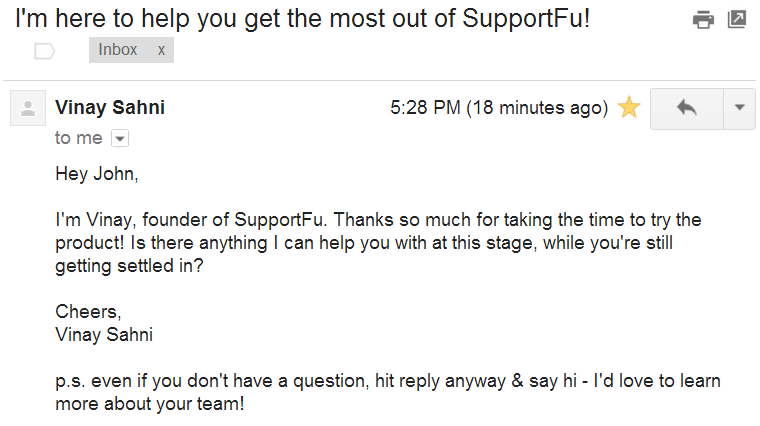11 Tips for Writing Effective Welcome Emails
You have a continuous stream of people signing up to try your product but don't have a continuous stream of feedback. It feels like you're driving blind - not even sure whether you're headed in the right direction. This is precisely the feeling I had in the early days of promoting Enchant.
Things didn't turn around for the better until I realized how much impact a well crafted welcome email can have. I used to send a welcome email for the sake of sending one, without putting much thought into it. In hindsight, this was a huge lost opportunity! With some simple tweaks, I was able to increase the rate of responses by 5 times! I now write these emails with a single goal in mind - to engage the customer and kick start a one-on-one relationship sooner. This has resulted in a continuous stream of valuable feedback which helps me guide the long term product vision.
This is the current iteration of the email I send for Enchant:

I send this by hand, usually after checking out the customer's website and including something unique to them (when possible).
Here are some tips on writing effective welcome emails, based on what I've learned from my experiments:
- Ensure the subject is interesting. You're fighting for attention in someone's inbox. It's easy to get lost in the crowd with a boring subject like "Welcome to Product X". Here is where it pays huge to come up with an engaging subject line. Just don't forget to mention your product since it's one thing that the reader will easily recognize. Here are some examples of interesting subject lines: "How to master customer wow with Enchant!" or "Enchant is going to change your life - let me show you how".
- Write in an genuine & personal voice. An email from a person is much more approachable than one from a company. The trick here is to write as if you're writing to someone you've known for years. I try to be the helpful friend who they can rely on if they get lost or confused.
- Use a real name in the From field. Just like the subject, the name in the from field is something that's visible before your email is ever opened. It's critical to use a real person's name here. However, since a person's name may not be easily recognizable, it's even better if you can include the company name. So, "Vinay from Enchant" is better than "Vinay Sahni" is better than "Team Enchant"
- Ensure it can be replied to. Nothing is less inviting than a no-reply email address. Although a generic help or support address is better, I strongly suggest using an address of a specific person. People feel more comfortable replying if they know exactly who it's going to.
- Echo their name back at them. Studies have shown that people love to hear their name. This is an easy one to implement - just make sure you collect their name at sign up and echo it back to them when sending the welcome email. If you can naturally squeeze it into the email more than once, even better!
- Be timely. Don't send the email as soon as they sign up and don't wait a day or two either. You see, people are used to getting emails the moment they sign up on websites, typically containing activation links. Although such emails have high open rates, they still have low engagement (and I'm not counting clicking an activation link as engagement). By delaying sending an email by a little bit, it will hit their inbox when they aren't expecting it and increase curiosity. For Enchant, the optimal time seems to be 40 - 120 minutes. By then, they've tried the product and still have it fresh in memory.
- Make it unique & send it by hand. If possible, add one to two sentences very specific to the customer in the email. There's nothing more powerful than an email that directly speaks to you and is more personal than any welcome email you've ever received! Obviously, this can't be automated and wouldn't be practical if you have a lot of sign ups.
- Ask a simple question. I really want to ask "Do you have any feedback?" - but that is a hard question! Writing an intelligent response to that question requires actually understanding how the product works. Instead, I reduce friction by asking a simpler question - something like "Do you need any help?" or "Do you have any questions?". Simple questions are easy to answer and initiate the conversation sooner. The harder questions can be asked later on once you have established rapport.
- Provide onboarding tips. At the end of the day, your customers are using your product to help them be more awesome at their jobs. If you have their attention, this is a great time to offer some tips on what they can do right now to get the most out of your product. This is especially beneficial if they weren't able to get very far and gave up. However, keep this short to prevent distraction from the real goal of initiating conversation!
- Invite them to email you. Even if you're following all the above tips, some people need that little extra nudge to push them to actually hit reply. I've found that asking directly can do wonders, even if they just take a moment to say hi! So stick it in to you email somewhere - I like to leave the nudge at the end email as a call to action.
- Say thank you. Let them know that they aren't just a number and you appreciate that they've taken time out of their day to try your product. A little gratitude will go a long way in building a lasting relationship.
It's really not that hard - be sincere, be human, be direct!
